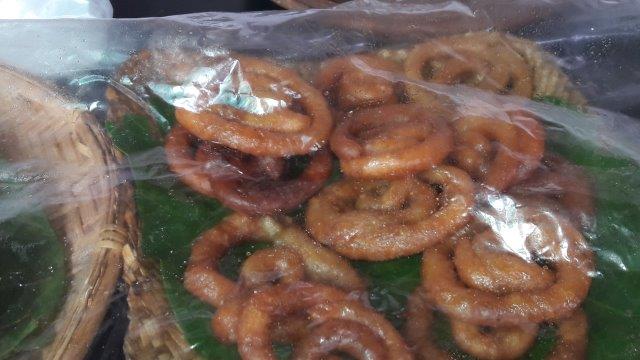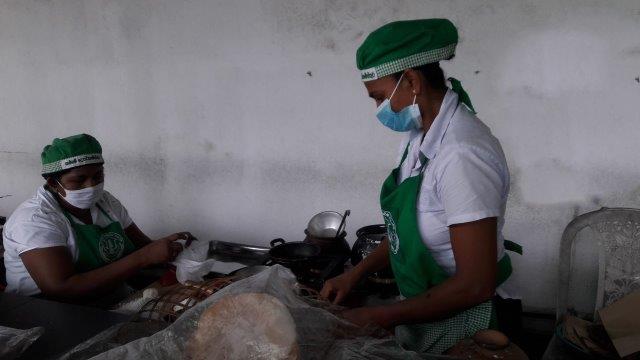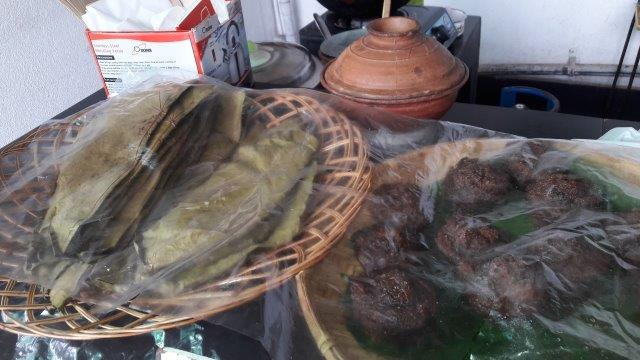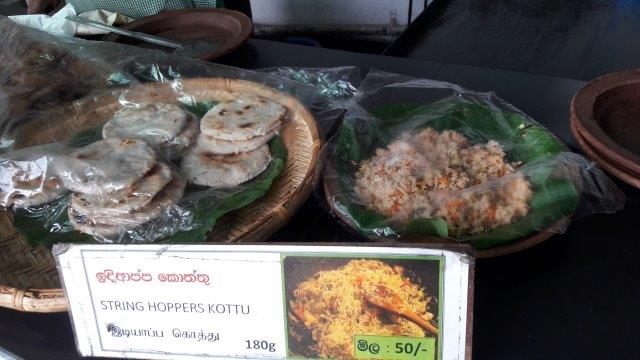Authentic Sri Lankan food at Hela Bojun Hala – By Arundathie Abeysinghe

 Hela Bojun Hala (Traditional Sri Lankan Food Court), serving quintessentially delicious fresh food at subsidized prices are situated in many places in Sri Lanka. Each food is vegetarian, fresh and healthy as well as free from flavors and additives. The first outlet of Hela Bojun Hala was started in Gannoruwa in Kandy as a pilot project with the objective of promoting fresh local food as well as empowering local women. Prices of food items range from Rs 25/= upwards and a whole meal costs around Rs. 300/= (about 2.2 AUD). Spacious with open kitchens, Hela Bojun Hala outlets are scattered throughout Sri Lanka from Kandy to Nuwara Eliya to Jaffna and Matara.
Hela Bojun Hala (Traditional Sri Lankan Food Court), serving quintessentially delicious fresh food at subsidized prices are situated in many places in Sri Lanka. Each food is vegetarian, fresh and healthy as well as free from flavors and additives. The first outlet of Hela Bojun Hala was started in Gannoruwa in Kandy as a pilot project with the objective of promoting fresh local food as well as empowering local women. Prices of food items range from Rs 25/= upwards and a whole meal costs around Rs. 300/= (about 2.2 AUD). Spacious with open kitchens, Hela Bojun Hala outlets are scattered throughout Sri Lanka from Kandy to Nuwara Eliya to Jaffna and Matara.
Initially, the project was set up by Women’s Agriculture Extension Program of the Ministry of Agriculture and at present the project is taken up by Provincial Agriculture Departments also.

Each food stall has a variety of items ranging from kiribath (milk rice), *pittu, hoppers, string hoppers, *those, *vandu appa, kiri appa (succulent hoppers made with rice flour and a generous amount of coconut milk), *levariya, rice *kottu, kos kottu (jackfruit kottu) and *olu rice. Certain food items such as polos cutlets (tender jackfruit cutlets), mushroom cutlets and keselmuwa cutlets (banana blossom cutlets) are not found elsewhere in Sri Lanka. In addition to *ulundu wade and *masala wade, *cowpea wade (a novel food item) are also sold in these outlets. Traditional sweetmeats such as *konda kevum, *mung kevum, *narang kevum*undu wel and *kokis are also sold at these outlets.

Tasty curries for string hoppers, thosai and hoppers include keselmuwa (banana blossom) curry or polos curry (tender jackfruit curry). *Pol sambol, an accomplishment for string hoppers or thosai are also prepared using freshly grated coconut. Except the mixture for thosai, all the ingredients for the meals such as rice flour and spices are ground at the outlets, thus retaining the freshness of each item. Food items are prepared in front of the customers and are hot tasty as well as fresh without too much salt or spices. Certain food items such as *mani pittu, kos (jackfruit) *kottu and *wandu appa are hardly available anywhere else in Sri Lanka. Sweetmeats are also not too sweet but succulent. Hence, everybody from a small child to an elderly person can have a tasty meal at a very affordable price at Hela Bojun Hala outlets.
Each outlet has a variety of fruit juices including passion fruit, soursop, avocado, woodapple, kola kenda (herbal porridge) as well as traditional herbal drinks such as *beli mal accompanied with a piece of jaggery.
The meals are wholesome and very filling. All food items in these outlets including pancakes are made using rice flour.
To serve food, porcelain plates are used instead of plastic plates. Cane baskets lined with banana leaves are used to sell certain food items such as hoppers or thosai whereas, *kenda leaves or banana leaves are used to wrap takeaway food.
As the concept of Hela Boju Hala is to produce substance free, fresh healthy food at low cost as well as promote local produce among consumers, females employed in these outlets are given extensive training on preparing healthy, hygienic food. Rural females with culinary skills are trained and recruited to work in these food outlets. If there is food left without being used, they are discarded.
Hela Boju Hala outlets are popular among locals as well as foreigners.
- Beli – Beli (Aegle marmelos), known in English as bael fruit is a highly nutritious fruit. The flower of the fruit (beli mal) is boiled and prepared as herbal tea in Sri Lanka. According to Ayurveda, beil mal herbal tea relieves palpitations, heart burn, increases appetite as well as cures bowel disorders.
- Cowpea – Rich in protein, cowpea (Vigna unguiculata) is a cereal cultivated in Asia and Africa. Cowpea has multiple uses; food for human beings and fodder for livestock. Cowpea is commonly referred to as blackeye pea and southern pea.
- Helapa – This is a traditional Sri Lankan delicacy eaten during tea time prepared with a combination of kurakkan (millet) flour, rice flour, treacle, cardamom and grated coconut. Helapa is steamed in wrapped *kenda
- Kenda – Kenda (Macaranga peltata) is a plant found in Sri Lanka, India and Thailand. Helapa dough is flattened on a kenda leaf and steamed to soak in the flavor of the leaf.
- Kokis – This is a deep-fried Sri Lankan traditional sweetmeat made from rice flour and coconut milk batter dipped in hot oil. This sweetmeat plays a major role during Sinhala and Tamil New Year celebrations. According to folklore, this sweetmeat has been introduced to Sri Lanka by Dutch.
- Kewum and Konda Kevum – Made with rice flour batter mixed with treacle and dipped in hot oil, kewum is a traditional Sri Lankan sweetmeat served during festivals.
- Kottu – A popular food item in Sri Lanka made with rice flour as the main ingredient mixed with crispy vegetables using aromatic spices prepared on a hot griddle.
- Kurakkan – This cereal is known as millet (Eleusine coracana) in English. The flour is gluten-free and is a source of calcium and iron. The flour is an excellent source of nutrition for children, nursing mothers, elderly, vegans and vegetarians.
- Levariya – Made from string hoppers and a filling of grated coconut mixed with boiled treacle.
- Mani pittu – A Sri Lankan delicacy made from rice flour.
- Mung Kevum and Narang Kevum – Made with a batter mixed with ground mung (green gram seed) and coconut milk cut into shapes and dipped in hot milk. Narang kevuwm is prepared with balls of ground green gram seed and coconut milk with a filling of grated coconut mixed with boiled treacle.
- Olu rice – A nutritious rice extracted from olu (water lily – Nymphaea pubescens) eaten for breakfast accompanied with coconut chutney.
- Pol sambol – A traditional Sri Lankan dish made with grated coconut ground with dried chilies, salt, onions and mixed with lime juice consumed with rice or string hoppers.
- Pittu – This is a food made of steamed ground rice mixed with grated coconut, popular in Sri Lanka, South Indian states of Kerala and Tamil Nadu.
- Thosai – A popular food in Sri Lanka usually accompanied with mixed vegetable curry (sambar), dhal and coconut chutney. This is a South Indian food also known as dosa. Thosai is similar to a pancake and made from fermented batter using *undu and cooked on a flat griddle. Thosai is a popular food among locals as well as foreigners in Sri Lanka.
- Undu – Undu is also known as Ulundu or Urad (Orid seeds). The seeds are ground and used to prepare thosai. Undu removes waste from the body and prevents constipation.
- Undu Wel – This is a Sri Lankan sweetmeat prepared with a batter using ground undu seeds, dipping batter in round shapes in hot oil, draining oil and dipping them in a mixture of treacle. This succulent sweetmeat is a popular snack during festivals in Sri Lanka.
- Wade – This is a popular snack in Sri Lanka also known as wada. There are two types of wade – ulundu wade (made from ground undu seeds) and dhal wade also known as masala wade (made from ground dhal) eaten piping hot with coconut chutney.
- Wandu Appa – This is a rare and delicious Sri Lankan food, a sweet hopper steamed in a wrapped kenda









No Comments